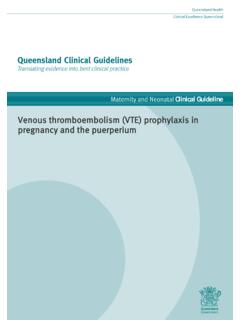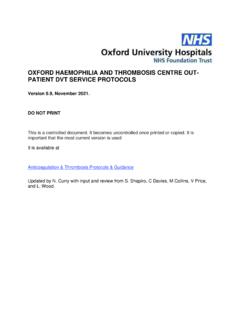Transcription of CLINICAL PRACTICE GUIDELINE: MOBILITY WITH A DEEP VEIN ...
1 Author(s): Fraser Health Physiotherapy Professional PRACTICE Council Shared Work Team CDST# : FHR-CPG-0012 NOTE: This is a controlled document for Fraser Health (FH) internal use only. FH accepts no responsibility for use outside of this health authority. The electronic version of this document in the CLINICAL Policy Office is the current version - any print versions should be checked against the electronic copy. CLINICAL PRACTICE GUIDELINE: MOBILITY WITH A deep VEIN thrombosis (DVT) AUTHORIZATION: Integrated Professional PRACTICE Council Date Released: June 3, 2010 Date Revised: April 12, 2013 Page 1 of 10 FOCUS: Mobilization with a deep Vein thrombosis (DVT). The purpose of this CLINICAL PRACTICE guideline (CPG) is to ensure that new knowledge is integrated across Fraser Health and to standardize evidence based mobilization strategies in patients with a DVT.
2 BACKGROUND DVT occurs in a diverse patient population with risk factors including, but not limited to, immobility, surgery, trauma, acute medical illness and malignancy. In the past, there have been recommendations of strict bed rest for a variable time after acute DVT and after the start of anticoagulation. More recently, research has shown that there is no difference between ambulation and bed rest on either the development of a (Pulmonary Embolism) PE (2, 8, and 9) or on the progression or development of a new DVT (5). Furthermore, the complications and cost of prescribed bed rest are well documented and early ambulation in preference to initial bed rest has been strongly recommended (9).
3 DEFINITIONS Activity as Tolerated (AAT): An order given by the physician indicating that the person can be active on the ward as tolerated by the person. Anticoagulation Therapy for Prophylaxis: The therapeutic use of anticoagulants to discourage/prevent the formation of blood clots (eg. Low dose subcutaneous heparin or low molecular weight heparin). Anticoagulation Therapy for Treatment: The therapeutic use of anticoagulants to prevent the extension/progression of an existing clot or thrombus (eg. Treatment doses of intravenous heparin, subcutaneous low molecular weight heparin and warfarin). Please see the anticoagulation appendix for more details. deep Vein thrombosis (DVT): A blood clot in a deep vein causing partial or complete blockage of blood flow.
4 Informed Consent: The process for obtaining voluntary agreement to health care based on full knowledge of the proposed health care and on the person s capability to make an informed decision. The health care provider s responsibility is to make every reasonable effort to give relevant information in a way that is best understood by the person and then obtain informed consent. Author(s): Fraser Health Physiotherapy Professional PRACTICE Council Shared Work Team CDST# : FHR-CPG-0012 NOTE: This is a controlled document for Fraser Health (FH) internal use only. FH accepts no responsibility for use outside of this health authority. The electronic version of this document in the CLINICAL Policy Office is the current version - any print versions should be checked against the electronic copy.
5 CLINICAL PRACTICE GUIDELINE: MOBILITY WITH A deep VEIN thrombosis (DVT) AUTHORIZATION: Integrated Professional PRACTICE Council Date Released: June 3, 2010 Date Revised: April 12, 2013 Page 2 of 10 Mobilization: In this context it refers to the person moving around ie transferring to a chair, ambulating around the ward. Pulmonary Embolism (PE): A blood clot in a pulmonary artery or one of its branches. Interdisciplinary team: A team of health care providers that represent more than one profession. EXPECTED OUTCOMES 1) Activity will be encouraged as tolerated once anticoagulation therapy for treatment has been started. 2) An individualized plan of care will be developed by the interdisciplinary team as required.
6 ASSESSMENT Once a person with a DVT or suspected DVT is referred to physiotherapy: 1) Check the chart to see if the person has been started on anticoagulation therapy for treatment. If it is not clear whether the patient is on anticoagulation therapy for prophylaxis or treatment, then check with the Pharmacist or Physician. If the person has not been started on anticoagulation therapy for treatment then all MOBILITY orders need to be checked with the physician. This should be done immediately as mobilization is generally more beneficial than detrimental. Rarely (eg. renal failure/ bariatric patients), a person may be put on IV heparin instead of Low Molecular Weight Heparin (LMWH). In this instance check MOBILITY orders with the physician.
7 If you are not sure what anticoagulation the person is on, check with the Physician or Pharmacist (See the anticoagulation appendix for more details). Rarely (eg. Cancer Patients), a persons DVT may be progressing despite being on anticoagulation therapy for treatment, in this case, check MOBILITY orders with the physician. 2) Check the chart to make sure there are no activity restrictions. If a patient is already on anticoagulation therapy for treatment (eg post-op patient) and a DVT is suspected or confirmed, there is no need to stop mobilization unless there are specific physician orders to do so. Author(s): Fraser Health Physiotherapy Professional PRACTICE Council Shared Work Team CDST# : FHR-CPG-0012 NOTE: This is a controlled document for Fraser Health (FH) internal use only.
8 FH accepts no responsibility for use outside of this health authority. The electronic version of this document in the CLINICAL Policy Office is the current version - any print versions should be checked against the electronic copy. CLINICAL PRACTICE GUIDELINE: MOBILITY WITH A deep VEIN thrombosis (DVT) AUTHORIZATION: Integrated Professional PRACTICE Council Date Released: June 3, 2010 Date Revised: April 12, 2013 Page 3 of 10 INTERVENTIONS 1) Interventions where a patient has contraindications to anticoagulation therapy for treatment: a) This guideline should not be used and all MOBILITY issues/orders should go through the physician. 2) Interventions where there is a suspected or diagnosed a) This guideline should not be used and all MOBILITY issues/orders should go through the physician.
9 3) Interventions where the patient has started anticoagulation therapy for treatment: a) Assess MOBILITY (Persons should be monitored for significant/substantial/major change in symptoms such as pain, swelling, color, sudden shortness of breath). Any changes should be reported to the physician for further investigation. b) Once MOBILITY has been assessed, the inter-disciplinary team should continue with MOBILITY as indicated and the patient should be encouraged to be as active as possible.* c) * It is recommended that patients with DVT also wear compression stockings (30-40 mm Hg) in order to decrease the incidence of post-thrombotic syndrome. DOCUMENTATION Ongoing documentation in the health record is required as per the College of Physical Therapists of British Columbia (CPTBC) Guidelines.
10 EDUCATION Engage in dialogue with the person/decision-maker during the process of all care and treatment. If MOBILITY is clinically indicated, provide information and advice for informed consent including: 1) Benefits and potential risk of mobilization with DVT Formatted: Font: 10 ptFormatted: Font: 10 pt Author(s): Fraser Health Physiotherapy Professional PRACTICE Council Shared Work Team CDST# : FHR-CPG-0012 NOTE: This is a controlled document for Fraser Health (FH) internal use only. FH accepts no responsibility for use outside of this health authority. The electronic version of this document in the CLINICAL Policy Office is the current version - any print versions should be checked against the electronic copy.





